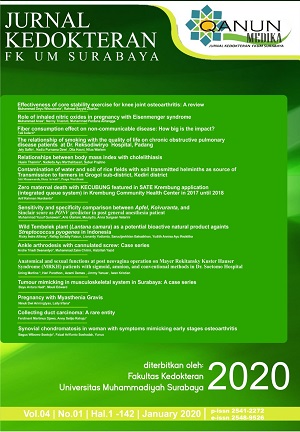Anatomical and Sexual Functions at Post Neovagina operation on Mayer Rokitansky Kuster Hauser Syndrome (MRKH) Patients with Sigmoid ,Amnion and Conventional Methods in Dr. Soetomo Hospital
Abstract
Â
ABSTRACT
Â
Background: The Mayer–Rokitansky–Kuster–Hauser (MRKH) syndrome is congenital malformation due to uteroâ€vaginal agenesis. For many years Dr Soetomo Hospital has been applying McIndoe technique using biomaterial amnion. Recently, in collaboration with digestive surgery, neovagina operation using sigmoid was performed. However, no data are available on the complications, anatomic, and functional results of the neovagina operation using sigmoid and amnion. Methods: MRKH patients who have performed neovagina operations from January 2011 to December 2014 were involved in this case review. The anatomical function was measured based on minimal vaginal length of more than 6 cm and width of 3 cm, while sexual performance is measured by Female Sexual Function Index (FSFI), which is above 23, and Female Sexual Distress Score Revised (FSDSR), whose score is < 11. Result: In 4 years period, there were 6 cases of MRKH underwent neovagina (1 used sigmoid and 5 used amnion) at Dr Soetomo Hospital. All of them had a satisfying anatomical and sexual function. Even though neovagina operation significantly reduces sexual distress, but it does not necessarily mean alleviate as seen by the high FSDSR score. Neovagina using amnion has faster operation time and cheaper with the same length of hospital stay than sigmoid neovagina. Sigmoid neovagina has a better vaginal length, lubrication and no need dilatation after operation, but it has higher complication risk. Conclusion: The Neovagina technique should be used at Soetomo Hospital depends on patient wishes and circumstances. For those who have strong financial support and are not willing to do manual dilatation, they should use the sigmoid neovagina, while those who are able to do manual dilatation, then the amnion neovagina is a good choice.
Keywords: Neovagina, MRKH, sigmoid, amnion, anatomic function
Â
Full text article
References
Chan, J. L., Levin, P. J., Ford, B. P., Stanton, D. C., & Pfeifer, S. M. (2017). Vaginoplasty with an Autologous Buccal Mucosa Fenestrated Graft in Two Patients with Vaginal Agenesis: A Multidisciplinary Approach and Literature Review. Journal of Minimally Invasive Gynecology, 24(4), 670–676. https://doi.org/10.1016/j.jmig.2016.12.030
Chandler, T. M., Machan, L. S., Cooperberg, P. L., Harris, A. C., & Chang, S. D. (2009). Müllerian duct anomalies: from diagnosis to intervention. The British Journal of Radiology, 82(984), 1034–1042. https://doi.org/10.1259/bjr/99354802
Fedele, L., Frontino, G., Restelli, E., Ciappina, N., Motta, F., & Bianchi, S. (2010). Creation of a neovagina by Davydov’s laparoscopic modified technique in patients with Rokitansky syndrome. American Journal of Obstetrics and Gynecology, 202(1), 33.e1-6. https://doi.org/10.1016/j.ajog.2009.08.035
Fotopoulou, C., Neumann, U., Klapp, C., Lichtenegger, W., & Sehouli, J. (2008). Long-term effects of neovaginal reconstruction with sigmoid loop technique on sexual function and self image in patients with gynecologic malignancies: Results of a prospective study. Gynecologic Oncology, 111(3), 400–406. https://doi.org/10.1016/j.ygyno.2008.09.018
Imparato, E., Alfei, A., Aspesi, G., Meus, A. L., & Spinillo, A. (2007). Long-term results of sigmoid vaginoplasty in a consecutive series of 62 patients. International Urogynecology Journal, 18(12), 1465–1469. https://doi.org/10.1007/s00192-007-0358-0
Liao, L.-M., Conway, G. S., Ismail-Pratt, I., Bikoo, M., & Creighton, S. M. (2011). Emotional and sexual wellness and quality of life in women with Rokitansky syndrome. American Journal of Obstetrics and Gynecology, 205(2), 117.e1-117.e6. https://doi.org/10.1016/j.ajog.2011.03.013
Lima, M., Ruggeri, G., Randi, B., Dòmini, M., Gargano, T., La Pergola, E., & Gregori, G. (2010). Vaginal replacement in the pediatric age group: a 34-year experience of intestinal vaginoplasty in children and young girls. Journal of Pediatric Surgery, 45(10), 2087–2091. https://doi.org/10.1016/j.jpedsurg.2010.05.016
Rawat, J., Ahmed, I., Pandey, A., Khan, T., Singh, S., Wakhlu, A., & Kureel, S. (2010). Vaginal agenesis: Experience with sigmoid colon neovaginoplasty. Journal of Indian Association of Pediatric Surgeons, 15(1), 19. https://doi.org/10.4103/0971-9261.69136
Rennie, K., Gruslin, A., Hengstschläger, M., Pei, D., Cai, J., Nikaido, T., & Bani-Yaghoub, M. (2012). Applications of Amniotic Membrane and Fluid in Stem Cell Biology and Regenerative Medicine. Stem Cells International, 2012, 1–13. https://doi.org/10.1155/2012/721538
S. Robert Kovac, Carl W Zimmerman. (2012). Advances in Reconstructive Vaginal Surgery (2nd ed.). Lippincott Williams & Wilkins.
Authors

Qanun Medika by FK UM Surabaya is liscence under Lisensi Creative Commons Atribusi 4.0 Internasional.

